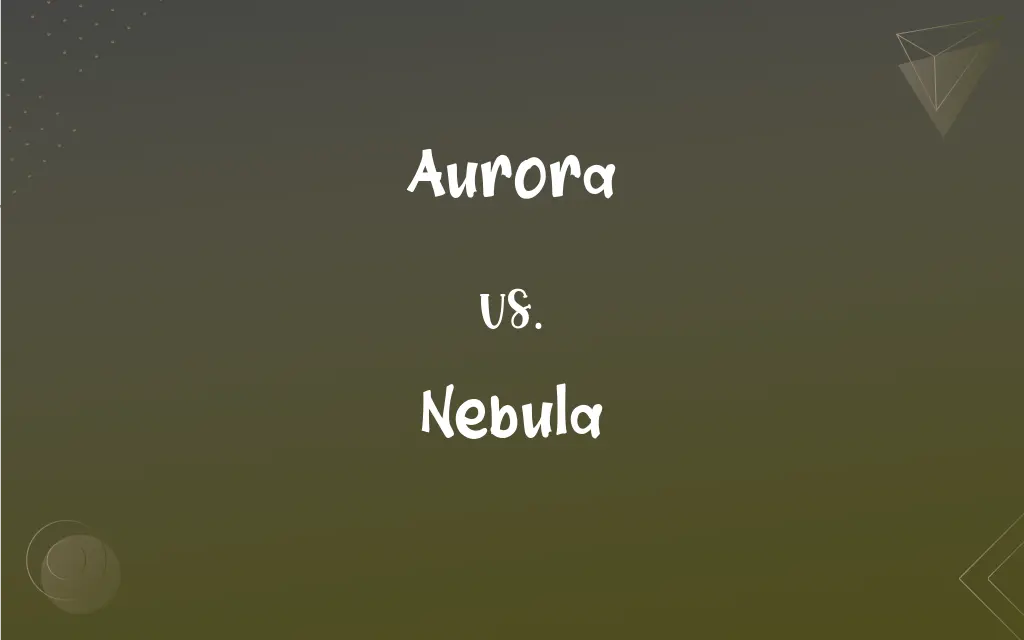Aurora vs. Nebula: What's the Difference?
By Aimie Carlson & Janet White || Updated on May 29, 2024
Aurora is a natural light display in the Earth's sky, primarily seen in polar regions, caused by charged particles from the sun. A nebula is a vast cloud of gas and dust in space, often the birthplace of stars.

Key Differences
Auroras, such as the Aurora Borealis in the Northern Hemisphere and the Aurora Australis in the Southern Hemisphere, are natural light displays typically seen in high-latitude regions around the Arctic and Antarctic. These colorful light shows occur when charged particles from the sun interact with the Earth's magnetic field and atmosphere, causing ionization and emission of light. On the other hand, a nebula is an enormous cloud of gas and dust in space, often many light-years across. Nebulae are regions where new stars are born, or remnants of dead or dying stars, and they come in various types such as emission, reflection, and dark nebulae. They can be observed with telescopes as diffuse, often colorful structures in the night sky.
While auroras are atmospheric phenomena occurring within the Earth's magnetosphere, nebulae are cosmic structures found far beyond our solar system. Auroras are transient and can be observed over short periods, whereas nebulae exist over millions or even billions of years.
Auroras are best observed from the Earth's surface in polar regions, whereas nebulae require telescopes for detailed observation and are studied in the context of astrophysics and cosmology.
Auroras are caused by solar wind interactions with the Earth's magnetic field, whereas nebulae form from the gravitational collapse of gas and dust or as remnants of supernovae.
Comparison Chart
Definition
Natural light display in Earth's sky
Vast cloud of gas and dust in space
ADVERTISEMENT
Cause
Interaction of solar wind with Earth's magnetic field
Gravitational collapse of gas and dust or supernova remnants
Location
Polar regions on Earth
Interstellar space, far beyond our solar system
Observation
Visible to the naked eye in polar regions
Requires telescopes for detailed observation
Duration
Transient, lasts from minutes to hours
Exists for millions to billions of years
Types
Aurora Borealis, Aurora Australis
Emission nebulae, reflection nebulae, dark nebulae
ADVERTISEMENT
Colors
Greens, pinks, reds, purples
Various colors depending on gas composition and excitation
Significance
Atmospheric and space weather phenomena
Star formation and remnants, cosmic structures
Aurora and Nebula Definitions
Aurora
A natural light display in the Earth's sky, predominantly seen in polar regions.
The aurora borealis lit up the night sky with brilliant greens and purples.
Nebula
A vast cloud of gas and dust in interstellar space.
The Orion Nebula is a well-known star-forming region visible through telescopes.
Aurora
Caused by the interaction of solar wind particles with the Earth's magnetosphere.
The aurora australis can be observed from Antarctica during periods of high solar activity.
Nebula
Observed as diffuse, often colorful structures in the night sky.
The Horsehead Nebula is famous for its distinctive shape.
Aurora
Known as the Northern and Southern Lights.
Tourists flock to Norway to witness the mesmerizing aurora borealis.
Nebula
Requires telescopes for detailed observation and study.
Astronomers study nebulae to understand star formation processes.
Aurora
Visible to the naked eye, best seen during clear, dark nights.
The aurora's colors were especially vivid against the dark, starry sky.
Nebula
Often the birthplace of stars or remnants of supernova explosions.
The Crab Nebula is the remnant of a supernova explosion recorded in 1054 AD.
Aurora
The goddess of the dawn.
Nebula
A diffuse cloud of interstellar dust or gas or both, visible as luminous patches or areas of darkness depending on the way the mass absorbs or reflects incident light or emits its own light.
Aurora
A luminous atmospheric phenomenon appearing as streamers or bands of light sometimes visible in the night sky in northern or southern regions of the earth. It is thought to be caused by charged particles from the sun entering the earth's magnetic field and stimulating molecules in the atmosphere.
Nebula
A galaxy. No longer in technical use.
Aurora
The dawn.
Nebula
A cloudy spot on the cornea.
Aurora
An atmospheric phenomenon created by charged particles from the sun striking the upper atmosphere, creating coloured lights in the sky. It is usually named australis or borealis based on whether it is in the Southern or Northern Hemisphere respectively.
Nebula
A liquid preparation for use in a nebulizer.
Aurora
The rising light of the morning; the dawn of day; the redness of the sky just before the sun rises.
Nebula
(astronomy) A cloud in outer space consisting of gas or dust (e.g. a cloud formed after a star explodes).
Aurora
The rise, dawn, or beginning.
Nebula
A white spot or slight opacity of the cornea.
Aurora
The Roman personification of the dawn of day; the goddess of the morning. The poets represented her a rising out of the ocean, in a chariot, with rosy fingers dropping gentle dew.
Nebula
A cloudy appearance in the urine.
Aurora
A species of crowfoot.
Nebula
A faint, cloudlike, self-luminous mass of matter situated beyond the solar system among the stars. The term was originally applied to any diffuse luminous region. Now, technically, it is applied to interstellar clouds of dust and gases (diffuse nebula). However distant galaxies and very distant star clusters often appear like them in the telescope, such as the spiral nebula in Andromeda, known now to be a distant galaxy.
Aurora
The aurora borealis or aurora australis (northern or southern lights).
Nebula
A white spot or a slight opacity of the cornea.
Aurora
The first light of day;
We got up before dawn
They talked until morning
Nebula
A medicinal liquid preparation intended for use in an atomizer
Aurora
An atmospheric phenomenon consisting of bands of light caused by charged solar particles following the earth's magnetic lines of force
Nebula
Cloudiness of the urine
Aurora
(Roman mythology) goddess of the dawn; counterpart of Greek Eos
Nebula
An immense cloud of gas (mainly hydrogen) and dust in interstellar space
Aurora
Transient phenomena occurring mainly at high latitudes.
The aurora appeared suddenly, dancing across the sky for a few hours.
Nebula
(pathology) a faint cloudy spot on the cornea
Nebula
Comes in various types, such as emission, reflection, and dark nebulae.
Emission nebulae glow brightly due to the ionization of gas by nearby stars.
FAQs
What is a nebula?
A nebula is a vast cloud of gas and dust in space, often serving as the birthplace of stars or as remnants of supernovae.
How do auroras form?
Auroras form when charged particles from the sun interact with the Earth's magnetic field, causing ionization and light emission in the atmosphere.
Where can you see auroras?
Auroras are best observed in polar regions, such as near the Arctic and Antarctic circles.
What colors are auroras?
Auroras typically display greens, pinks, reds, and purples.
What colors are nebulae?
Nebulae can display various colors depending on their gas composition and the types of excitation, such as red, blue, green, and yellow.
Can you see nebulae with the naked eye?
Some nebulae can be seen as faint, diffuse objects with the naked eye, but detailed observation requires telescopes.
What is an aurora?
An aurora is a natural light display in the Earth's sky, primarily seen in polar regions, caused by solar wind particles interacting with the Earth's magnetic field.
Where can you see nebulae?
Nebulae are observed through telescopes, often appearing as diffuse, colorful objects in the night sky.
Are auroras temporary?
Yes, auroras are transient and can last from minutes to hours.
How do nebulae form?
Nebulae form from the gravitational collapse of gas and dust or as remnants of supernova explosions.
What causes the different colors in nebulae?
The colors in nebulae result from different elements emitting light at specific wavelengths when ionized, such as hydrogen emitting red and oxygen emitting green or blue.
Can you see auroras with the naked eye?
Yes, auroras can be seen with the naked eye, especially in dark, clear skies in polar regions.
What are the main types of nebulae?
The main types of nebulae include emission nebulae, reflection nebulae, and dark nebulae.
How do nebulae impact the cosmos?
Nebulae play a crucial role in star formation and the recycling of cosmic material, impacting the evolution of galaxies.
Do auroras occur only on Earth?
No, auroras also occur on other planets with magnetic fields and atmospheres, such as Jupiter and Saturn.
Are nebulae only found in the Milky Way?
No, nebulae are found throughout the universe, including other galaxies.
Are nebulae permanent?
Nebulae exist for millions to billions of years, although their appearance can change over time.
What causes the different colors in auroras?
The colors in auroras are caused by different gases in the Earth's atmosphere being ionized, such as oxygen producing green and red, and nitrogen producing blue and purple.
What are the main types of auroras?
The main types of auroras are the Aurora Borealis (Northern Lights) and the Aurora Australis (Southern Lights).
How do auroras affect Earth?
Auroras are a visual manifestation of solar wind interactions and do not directly affect the Earth, but the solar activity causing them can impact satellite communications and power grids.
About Author
Written by
Aimie CarlsonAimie Carlson, holding a master's degree in English literature, is a fervent English language enthusiast. She lends her writing talents to Difference Wiki, a prominent website that specializes in comparisons, offering readers insightful analyses that both captivate and inform.
Co-written by
Janet WhiteJanet White has been an esteemed writer and blogger for Difference Wiki. Holding a Master's degree in Science and Medical Journalism from the prestigious Boston University, she has consistently demonstrated her expertise and passion for her field. When she's not immersed in her work, Janet relishes her time exercising, delving into a good book, and cherishing moments with friends and family.































































